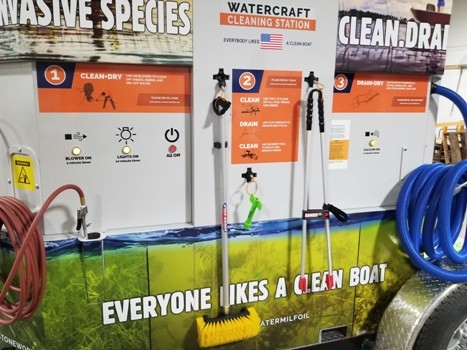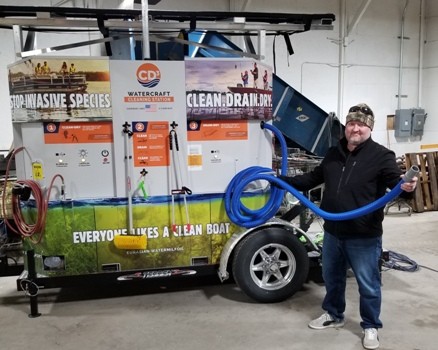The Polk County Aquatic Invasive Species (AIS) Task Force purchased a new portable boat cleaning station. The station, funded through state grant dollars, should help fight the spread of aquatic invasive species to other Polk County Lakes.
Assistant Director of Environmental Service Jake Snyder said they’ve tested the components on the trailer in preparation for boating season. “We’re doing some testing on it and making sure that once we put in on an access site, it’s going to be what we thought it was,” said Snyder. “So far, so good. We’ve done some testing on the tools to make sure everything works. It’s solar-powered, off the grid set up on a trailer so that it can be hauled to some different sites.”
The AIS Task Force purchased the stations by saving grant dollars accumulated over several years. Snyder also said they ran some pilot programs to see if lake users would use the tools made available to them. “Last year, we did a number of tool outposts,” said Snyder. “Signs that said stop AIS. They had a brush and a couple of other tools on there, and people seemed to use them. That was our pilot that if we put something out there, would people use it. Would our lake users take the time to scrub down the boat, kayak, whatever it is they’re launching in our lakes or rivers? Our inspectors gave us feedback that people are using them. That translated to we should take the plunge.”
The new station aims to get boats dry, making them inhabitable for AIS. “There are four tools on it,” said Snyder. “A wet-dry vac, a grabber tool to grab weeds under the trailer or board, a brush, and compressor to blow air. It’s really not to hose off the unit or anything. If it had that, we’d have to collect the water and make sure it’s not going into whatever lake it’s parked on. The theory behind the station is to clean, drain, and dry boats. Aquatic Invasive Species need water to live, so the goal is to have cleaned, drained, dry boats, trailers, and watercraft equipment to combat spreading them around.”
The cleaning station will be another easy tool in the toolbox for the county’s inspectors. “When you leave the lake, head over to it,” said Snyder. “Take the little bit of extra water out of the live well and billage compartments. And the goal is to make it easy for the public to use. It’s totally free. You don’t pay to use it; you don’t put coins in it to make it start. Use it, clean the boats, stop the spread of anything that you bring lake to lake.”
While there is still ice on the lakes, Snyder said once boats can be in the water, the station will be moved to access sites around the county, some of which will require DNR permitting. “When the lakes thaw out, that will be deployed,” said Snyder. “Whenever we can get the permits in place is the kicker. We only have a couple of access sites that Polk County owns that we don’t need authorization from the DNR to put out. We have the campground on Maple Lake, and we own and operate the East Shore on Maple Lake. There is the campground on Cross Lake, so there are some access sites where we don’t need the DNR authorization to put it out. If the warming trend continues and we’re out of ice fishing season quick and into boat season, that will be out.”







